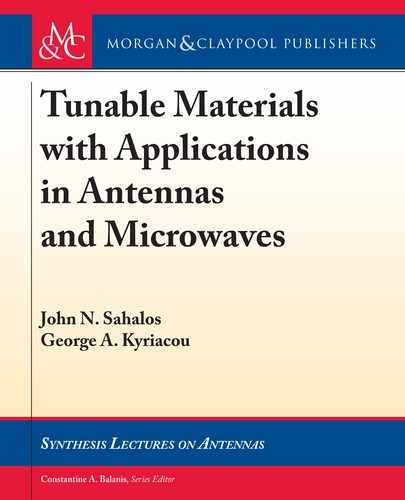
202 5. PLANAR TRANSMISSION LINES
Once again, we observe in Eqs. (5.35), (5.37), and (5.38) that the filling factors of suc-
cessive layers .i; i C 1/ have a common term. us, the effective permittivity of (5.31) can be
formulated as:
"
reff
D 1 C
1
2
M
X
iD1
"
l
ri
"
l
riC1
K
k
0
"
K
.
k
"
/
K
.
k
i"
/
K
k
0
i"
C
1
2
N
X
j
D
1
"
u
rj
"
u
rjC1
K.k
0
"
/
K.k
"
/
K.k
j"
/
K.k
0
j"
/
: (5.43)
Assuming two top .M D 2/ and three bottom .N D 3/ layers, we can see that Eq. (5.43)
becomes identical to that given in [30]. Hence, the same expression applies for the finite ground
plane CPW, but with the arguments of complete elliptic integrals substituted by those given
in [30]:
k
i
D
sinh
X
c
2h
i
sinh
X
b
2h
i
v
u
u
u
t
sinh
2
X
b
2h
i
sinh
2
X
a
2h
i
sinh
2
X
b
2h
i
sinh
2
X
a
2h
i
k
0
i
D
q
1 k
2
i
: (5.44)
Observing the geometry of Figure 5.7a, we can use the identity [25]:
sinh
2
.
Z
1
/
sinh
2
.
Z
2
/
D sinh
.
Z
1
C Z
2
/
sinh
.
Z
1
Z
2
/
:
Also, from Figure 5.7a, we have that X
c
X
b
D g; X
b
X
a
D w; X
b
D w C S=2; X
c
D
g C w C S=2 and S D 2X
a
. So,
k
i
D
sinh
4h
i
.S C 2g C 2w/
sinh
4h
i
.S C 2w/
v
u
u
u
t
sinh
2h
i
.S C w/
sinh
4h
i
w
sinh
2h
i
.g C w C S/
sinh
2h
i
.g C w/
: (5.45)
Equation (5.45) can be exactly reduced to (5.32a) when the width of the ground plane
tends to infinity (g ! 1). Also, for a single-layer substrate .M D 1; N D 0/, the effective per-
mittivity expression (5.43) is reduced to Eq. (5.42b).
5.12.1 CHARACTERISTIC IMPEDANCE
According to the classical quasi-static approximation, e.g., Pozar [1] or Gupta et al. [4], the
effective dielectric constant ."
reff
/, the phase velocity .V
p
/, and the characteristic impedance .Z
0
/
can be written in terms of the line capacitance with and without the dielectric layers loading.

5.12. MULTILAYER CPW WITH FINITE GROUND PLANES 203
Explicitly:
"
reff
D
C
C
0
D
Capacitance per unit length with dielectric layers
Capacitance per unit length with the strip conductors in the air
(5.46)
V
p
D
C
light
p
"
reff
; (5.47)
where C
light
is the wave velocity (or light velocity) in free space (C
light
D 1=
p
0
"
0
).
Z
0
D
1
C V
p
D
p
"
reff
C C
light
D
1
C C
0
p
"
reff
: (5.48)
From Eq. (5.48), one may observe that the only missing quantity is the quasi-static ca-
pacitance .C
0
/ per unit length when the strip conductors are immersed in air. Veyres and Fouad
Hanna [32], using conformal mapping, evaluated C
0
as:
C
0
D 4"
0
K
0
.k
0
/
K.k
0
/
D 4"
0
K.k
0
0
/
K.k
0
/
: (5.49)
For a symmetric CPW with finite ground conductor as in Figure 5.6, K is defined in [32]
and repeated in [30] as:
k
0
D
X
c
X
b
s
X
2
b
X
2
a
X
2
c
X
2
a
D
1 C
2g
S C 2w
w .s C w/
.g C w/ .g Cs C w/
1=2
: (5.50a)
For a symmetric CPW with infinite ground, k
0
can be obtained by taking the limit g ! 1
in Eqs. (5.50), which is also given by [4] as:
k
0
D
s
s C 2w
: (5.50b)
Fouad Hanna and ebault [32] gave the corresponding analysis for the asymmetric CPW
and infinite ground strips:
k
0
D
s
2
1 C ˛
w
1
C
s
2
s
2
C w
1
C ˛
s
2
2
(5.50c)
˛ D
w
1
w
2
C
s
2
.w
1
C w
2
/ ˙
f
w
1
w
2
.s C w
1
/.s C w
2
/
g
1=2
s
2
2
.w
1
w
2
/
: (5.50d)
..................Content has been hidden....................
You can't read the all page of ebook, please click here login for view all page.
